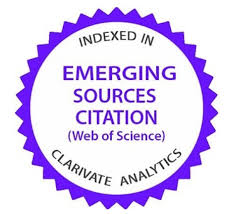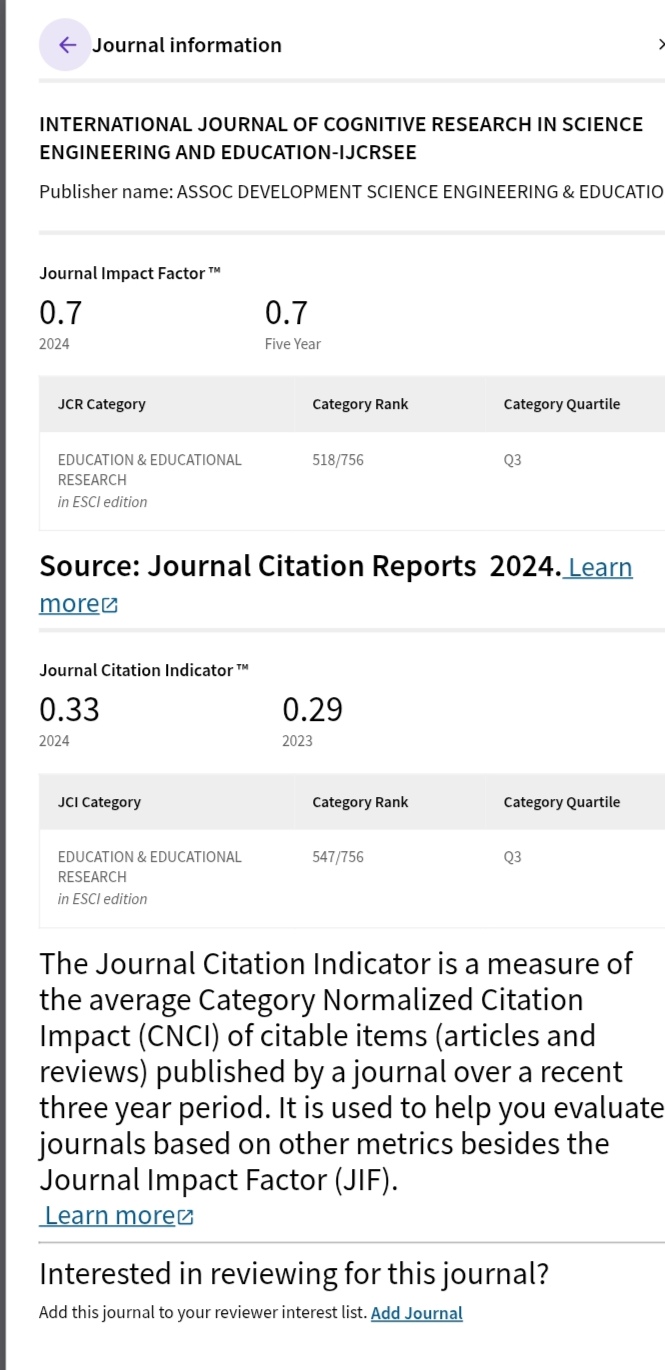Internet Addiction Disorder (IAD) as a Consequence of the Expansion of Information Technologies
##plugins.pubIds.doi.readerDisplayName##:
https://doi.org/10.23947/2334-8496-2022-10-3-155-165Кључне речи:
Internet addiction disorder, digital violence, the Internet, information technologies, digital expansionСажетак
Internet addiction disorder (IAD) is a global topic that increasingly attracts the attention of the wider public. The purpose of this paper is to research the current situation in the prevalence of both Internet addiction and problematic Internet use, which is the most common precursor to developing psychological disorders related to the relationship to the Internet and its elements. The initial hypotheses of this paper are that the Internet addiction disorder is more widespread and harmful than can be deduced from the attitude of society and health authorities towards it and that it calls for renewed theoretical and empirical research, which is the attitude shared by the scientific community. The results that we stated in the paper clearly show numerous mental and physical deficiencies and problems that are experimentally proven and presented in the paper. As a recommendation, we would point to increasing awareness of the dangers of excessive and problematic use of the Internet, offering healthy alternatives, promoting the culture of safe use of the Internet, as well as educating individuals on other self-control mechanisms. Attention should be constantly paid to dangers that realistically exist, and it should be permanently worked on this aspect of mental health of individuals, nations, and the global society.
##plugins.generic.usageStats.downloads##
Референце
Aboujaoude, E., Koran, L. M., Gamel, N., Large, M. D., & Serpe, R. T. (2006). Potential Markers for Problematic Internet Use: A Telephone Survey of 2,513 Adults. CNS Spectrums, 11(10), 750–755. https://doi.org/10.1017/s1092852900014875 DOI: https://doi.org/10.1017/S1092852900014875
Ary, D. V., Duncan, T. E., Biglan, A., Metzler, C. W., Noell, J. W., & Smolkowski, K. (1999). Development of adolescent problem behavior. Journal of abnormal child psychology, 27(2), 141–150. https://doi.org/10.1023/a:1021963531607 DOI: https://doi.org/10.1023/A:1021963531607
Basu, D., & Dalal, P. (2016). Twenty years of Internet addiction . . . Quo Vadis? Indian Journal of Psychiatry, 58(1), 6. https://doi.org/10.4103/0019-5545.174354 DOI: https://doi.org/10.4103/0019-5545.174354
Bjelajac, Ž., & Filipović, A. (2021). Specific characteristics of digital violence and digital crime. Pravo - Teorija i Praksa, 38(4), 16–32. https://doi.org/10.5937/ptp2104016b DOI: https://doi.org/10.5937/ptp2104016B
Bjelajac, Ž., & Filipović, A. M. (2020). Internet Addiction Disorder (IAD) as a paradigm of lack of security culture. Kultura Polisa, 17(43), 239–258. Retrieved from https://www.kpolisa.com/index.php/kp/article/view/244
Bjelajac, Ž. & Filipović, A.M. (2019). Misuse of the Internet as a part of security challenges, risks and threats”. SETI I 2019, Book of Proceedings. 483-495.
Bovina, I., & Dvoryanchikov, N. (2020a). Online and Offline Behavior: Does one Predict Another? Cultural-Historical Psychology, 16(4), 98–108. https://doi.org/10.17759/chp.2020160410 DOI: https://doi.org/10.17759/chp.2020160410
Bovina, I., & Dvoryanchikov, N. (2020b). Online and Offline Behavior: Two Realities or One? Психологическая Наука и Образование, 25(3), 101–115. https://doi.org/10.17759/pse.2020250309 DOI: https://doi.org/10.17759/pse.2020250309
Carr, N. (2010). The Shallows: What the Internet Is Doing to Our Brains. W. W. Norton Company.
Černja, I., Vejmelka, L., & Rajter, M. (2019). Internet addiction test: Croatian preliminary study. BMC Psychiatry, 19(1). https://doi.org/10.1186/s12888-019-2366-2 DOI: https://doi.org/10.1186/s12888-019-2366-2
Dimitrijević, I. (2007). U veku droge: priručnik za porodicu i školu [In the age of drugs: a handbook for families and schools]. Self-published.
Дворянчиков, Н. В., & Бовина, И. Б. (2022). Факторы риска и уязвимости в интернет-пространстве [Risk factors and vulnerabilities in the Internet space]. In Отклоняющееся онлайн-поведение подростков и молодых взрослых в социальных сетях - Учебное пособие под. ред. Дворянчикова Н.В. и Рубцовой О.В. Московский государственный психолого-педагогический университет.
Ghassemzadeh, L., Shahraray, M., & Moradi, A. (2008). Prevalence of Internet Addiction and Comparison of Internet Addicts and Non-Addicts in Iranian High Schools. CyberPsychology & Behavior, 11(6), 731–733. https://doi.org/10.1089/cpb.2007.0243 DOI: https://doi.org/10.1089/cpb.2007.0243
Greenfield D. M., & Sutker C. (1999). Virtual Addiction: Help for Netheads, Cyber-freaks, and Those Who Love Them. New Harbinger.
HerNetRights. 2017. Mapping the state of online violence against women and girls in Europe. European Women’s Lobby. Retrieved from https://www.womenlobby.org/IMG/pdf/hernetherrights_report_2017_for_web.pdf
Hops, H., Tildesley, E., Lichtenstein, E., Ary, D., & Sherman, L. (1990). Parent-adolescent problem-solving interactions and drug use. The American journal of drug and alcohol abuse, 16(3-4), 239-258. https://doi.org/10.3109/00952999009001586 DOI: https://doi.org/10.3109/00952999009001586
Internet Addiction. (n.d.). (2017) Psychology Today. Retrieved September 24, 2022, from https://www.psychologytoday.com/intl/basics/internet-addiction.
Ileš, Marina. (n.d.). Digitalno nasilje protiv žena i devojčica [Digital violence against women and girls]. Autonomni ženski centar. Retrieved from https://mogudanecu.rs/wp-content/themes/azc-zene/assets/files/Digitalno-nasilje-protiv-zena-i-devojcica.pdf
Johansson, A., & Götestam, K. G. (2004). Problems with Computer Games without Monetary Reward: Similarity to Pathological Gambling. Psychological Reports, 95(2), 641–650. https://doi.org/10.2466/pr0.95.2.641-650 DOI: https://doi.org/10.2466/pr0.95.2.641-650
Kaltiala-Heino, R., Lintonen, T., & Rimpelä, A. (2004). Internet addiction? Potentially problematic use of the Internet in a population of 12-18 year-old adolescents. Addiction Research & Theory, 12(1), 89–96. https://doi.org/10.1080/1606635031000098796 DOI: https://doi.org/10.1080/1606635031000098796
Kim, K., Ryu, E., Chon, M. Y., Yeun, E. J., Choi, S. Y., Seo, J. S., & Nam, B. W. (2006). Internet addiction in Korean adolescents and its relation to depression and suicidal ideation: A questionnaire survey. International Journal of Nursing Studies, 43(2), 185–192. https://doi.org/10.1016/j.ijnurstu.2005.02.005 DOI: https://doi.org/10.1016/j.ijnurstu.2005.02.005
Ko, C. H., Yen, J. Y., Chen, C. C., Chen, S. H., & Yen, C. F. (2005). Proposed Diagnostic Criteria of Internet Addiction for Adolescents. The Journal of Nervous and Mental Disease, 193(11), 728–733. https://doi.org/10.1097/01.nmd.0000185891.13719.54 DOI: https://doi.org/10.1097/01.nmd.0000185891.13719.54
Kovačević-Lepojević, M. (2011). Pojam i karakteristike internet-zavisnosti [Concept and characteristics of internet addiction]. Zbornik rezimea sa stručno-naučne konferencije Dani defektologa Srbije, 10(4). 615-631. Retreived from https://rfasper.fasper.bg.ac.rs/handle/123456789/4168
Kont, (2017, September 15). Интернет-зависимость: понятие, виды, симптомы, стадии и причины развития, лечение и профилактика [Internet addiction: concept, types, symptoms, stages and causes of development, treatment and prevention]. Retrieved from http://cont.ws/@adviser095/713682
Križić, P. (2017, September 21). Virtualno nasilje među mladima [Virtual violence among young people]. Digitalni Repozitorij Ocjenskih Radova Sveučilišta U Zadru. Retrieved from https://repozitorij.unizd.hr/islandora/object/unizd:1375
Leung, L. (2004). Net-Generation Attributes and Seductive Properties of the Internet as Predictors of Online Activities and Internet Addiction. CyberPsychology & Behavior, 7(3), 333–348. https://doi.org/10.1089/1094931041291303 DOI: https://doi.org/10.1089/1094931041291303
Maksimović, J., & Dimić, N. (2016). Digital technology and teachers’ competence for its application in the classroom. Research in Pedagogy, 6(2), 59-71. https://doi.org/10.17810/2015.35 DOI: https://doi.org/10.17810/2015.35
Maksimović, J., Osmanović, J., & Mamutović, A. (2020). Kompetencije nastavnika za medijsko obrazovanje. In medias res: časopis filozofije medija, 9(17), 2685-2707. https://doi.org/10.46640/imr.9.17.7 DOI: https://doi.org/10.46640/imr.9.17.7
Mascia, M. L., Agus, M., & Penna, M. P. (2020). Emotional Intelligence, Self-Regulation, Smartphone Addiction: Which Relationship With Student Well-Being and Quality of Life? Frontiers in Psychology, 11. https://doi.org/10.3389/fpsyg.2020.00375 DOI: https://doi.org/10.3389/fpsyg.2020.00375
Mascia, M. L., Agus, M., Zanetti, M. A., Pedditzi, M. L., Rollo, D., Lasio, M., & Penna, M. P. (2021). Moral Disengagement, Empathy, and Cybervictim’s Representation as Predictive Factors of Cyberbullying among Italian Adolescents. International Journal of Environmental Research and Public Health, 18(3), 1266. https://doi.org/10.3390/ijerph18031266 DOI: https://doi.org/10.3390/ijerph18031266
Mascia, M. L., Bonfiglio, N. S, Renati, R., Cataudella, S., Tomczyk, Ł., Penna, M. (2022). Problematic smartphone use and cognitive failures. An explorative study among free different generations (X, Y, Z). In 19th International Conference on Cognition and Exploratory Learning in Digital Age (CELDA 2022), Lisbon: IADIS p.233-240 ISBN: 978-989-8704-43-6.
Малыгин, В. Л., Хомерики, Н. С., Смирнова, Н. С. & Антоненко, А. А. (2011). Интернет-зависимое поведение [Понашање зависности од интернета]. Журнал неврологии и психиатрии, 8, 86-92. Retreived from https://www.researchgate.net/profile/V-Malygin/publication/221718549_Internet_addictive_behaviour/links/5fce97e4299bf188d4fffc0b/Internet-addictive-behaviour.pdf
Morahan-Martin, J., & Schumacher, P. (2000). Incidence and correlates of pathological Internet use among college students. Computers in Human Behavior, 16(1), 13–29. https://doi.org/10.1016/s0747-5632(99)00049-7 DOI: https://doi.org/10.1016/S0747-5632(99)00049-7
Петракова Т.И. (1995). Предикторы риска аддиктивного поведения и профилактика наркологических заболеваний среди подростков [Predictors of the risk of addictive behavior and prevention of narcological diseases among adolescents]. Вопросы наркологии, 2, 79-82. Retreived from https://www.elibrary.ru/item.asp?id=42975549
Rasel, Dž. B. (1982). Mit o đavolu [The myth of the devil], Jugoslavija.
Statistics Laundering, Online Pornography and the Daily Mail. (2013, May 23). Ministry of Truth. Retrieved from https://www.ministryoftruth.me.uk/2013/05/22/statistics-laundering-online-pornography-and-the-daily-mail/
Stošić, L., & Stošić, I. (2015). Perceptions of teachers regarding the implementation of the internet in education. Computers in Human Behavior, 53, 462–468. https://doi.org/10.1016/j.chb.2015.07.027 DOI: https://doi.org/10.1016/j.chb.2015.07.027
Stošić, L. (2015). The importance of educational technology in teaching. International Journal of Cognitive Research in Science, Engineering and Education, 3(1), 111–114. https://doi.org/10.23947/2334-8496-2015-3-1-111-114 DOI: https://doi.org/10.23947/2334-8496-2015-3-1-111-114
Tereshchenko, S., Kasparov, E., Smolnikova, M., Shubina, M., Gorbacheva, N., & Moskalenko, O. (2021). Internet Addiction and Sleep Problems among Russian Adolescents: A Field School-Based Study. International Journal of Environmental Research and Public Health, 18(19), 10397. https://doi.org/10.3390/ijerph181910397 DOI: https://doi.org/10.3390/ijerph181910397
Tomczyk, L., & Solecki, R. (2019). Problematic Internet Use and Protective Factors Related to Family and Free Time Activities among Young People. Educational Sciences: Theory & Practice, 19(3). https://doi.org/10.12738/estp.2019.3.001 DOI: https://doi.org/10.12738/estp.2019.3.001
Tomczyk, L., Fedeli, L., Stosic, L., Lizde, E. S., & Martins, V. F. (2021). Phubbing among adolescents and problematic smartphone use by their parents - a new challenge for media education. 2021 XVI Latin American Conference on Learning Technologies (LACLO). https://doi.org/10.1109/laclo54177.2021.00053 DOI: https://doi.org/10.1109/LACLO54177.2021.00053
Tomczyk, L., Szyszka, M., & Stošić, L. (2020). Problematic Internet Use among Youths. Education Sciences, 10(6), 161. https://doi.org/10.3390/educsci10060161 DOI: https://doi.org/10.3390/educsci10060161
Ukropina, N. (2019, March 11th). Četvrta industrijska revolucija [The fourth industrial revolution]. Centar za tehnološki menadžment Fakulteta organizacionih nauka. Retreived from http://ctm.fon.bg.ac.rs/2019/03/11/cetvrta-industrijska-revolucija/
Wallace, P. (2014). Internet addiction disorder and youth. EMBO Reports, 15(1), 12–16. https://doi.org/10.1002/embr.201338222 DOI: https://doi.org/10.1002/embr.201338222
Wallace, P. (2015). The psychology of the Internet. Cambridge University Press. Retrieved from http://dspace.opengeek.cl/bitstream/handle/uvscl/1413/The%20Psychology%20of%20the%20Internet.pdf?sequence=1&isAllowed=y DOI: https://doi.org/10.1017/CBO9781139940962
Yoo, H. J., Cho, S. C., Ha, J., Yune, S. K., Kim, S. J., Hwang, J., Chung, A., Sung, Y. H., & Lyoo, I. K. (2004). Attention deficit hyperactivity symptoms and Internet addiction. Psychiatry and Clinical Neurosciences, 58(5), 487–494. https://doi.org/10.1111/j.1440-1819.2004.01290.x DOI: https://doi.org/10.1111/j.1440-1819.2004.01290.x
Young, K. S. (1998). Internet Addiction: The Emergence of a New Clinical Disorder. CyberPsychology & Behavior, 1(3), 237–244. https://doi.org/10.1089/cpb.1998.1.237 DOI: https://doi.org/10.1089/cpb.1998.1.237
Young, K. S. (2008). Internet Sex Addiction. American Behavioral Scientist, 52(1), 21–37. https://doi.org/10.1177/0002764208321339 DOI: https://doi.org/10.1177/0002764208321339
Young, K. S. (2004). Internet Addiction: A New Clinical Phenomenon and Its Consequences. American Behavioral Scientist, 48(4), 402–415. https://doi.org/10.1177/0002764204270278 DOI: https://doi.org/10.1177/0002764204270278
Young, K. S., & De Abreu, C. N. (Eds.). (2010). Internet addiction: A handbook and guide to evaluation and treatment. John Wiley & Sons.
##submission.downloads##
Објављено
Како цитирати
Bрој часописа
Секција
##category.category##
Лиценца
Сва права задржана (c) 2022 Željko Bjelajac, Aleksandar M. Filipović, Lazar V. Stošić

Овај рад је под Creative Commons Aуторство 4.0 Интернационална лиценца.
##plugins.generic.plaudit.displayName##
##plugins.generic.dates.accepted## 2022-12-09
##plugins.generic.dates.published## 2022-12-20











